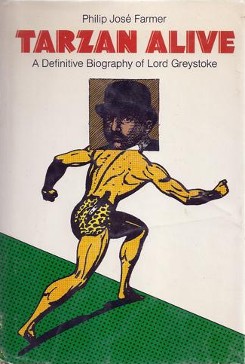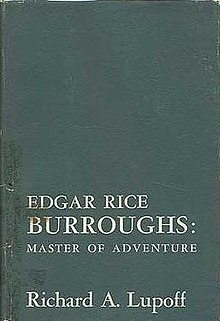
Edgar Rice Burroughs was an American writer, best known for his prolific output in the adventure, science fiction, and fantasy genres. Best known for creating the characters Tarzan and John Carter, he also wrote the Pellucidar series, the Amtor series, and the Caspak trilogy.

Pellucidar is the internal surface of a fictional Hollow Earth invented by American writer Edgar Rice Burroughs for a series of action adventure stories. In a crossover event, Tarzan, who was also created by Burroughs, visits Pellucidar.

John Carter of Mars is a fictional Virginian soldier who acts as the initial protagonist of the Barsoom stories by Edgar Rice Burroughs. A veteran of the American Civil War, he is transported to the planet Mars, called Barsoom by its inhabitants, where he becomes a warrior battling various mythological beasts, alien armies and malevolent foes. Created in 1911, the character has appeared in novels and short stories, comic books, television shows and films, including the 2012 feature film John Carter, which marked the 100th anniversary of the character's first appearance.

A Princess of Mars is a science fantasy novel by American writer Edgar Rice Burroughs, the first of his Barsoom series. It was first serialized in the pulp magazine All-Story Magazine from February–July, 1912. Full of swordplay and daring feats, the novel is considered a classic example of 20th-century pulp fiction. It is also a seminal instance of the planetary romance, a subgenre of science fantasy that became highly popular in the decades following its publication. Its early chapters also contain elements of the Western. The story is set on Mars, imagined as a dying planet with a harsh desert environment. This vision of Mars was based on the work of the astronomer Percival Lowell, whose ideas were widely popularized in the late 19th and early 20th centuries.

Roy Gerald Krenkel, who often signed his work RGK, was an American illustrator who specialized in fantasy and historical drawings and paintings for books, magazines and comic books.
Robert Kennedy Abbett was an American artist and illustrator.

Richard Allen Lupoff was an American science-fiction and mystery author, who also wrote humor, satire, nonfiction and reviews. In addition to his two dozen novels and more than 40 short stories, he also edited science-fantasy anthologies. He was an expert on the writing of Edgar Rice Burroughs, and had an equally strong interest in H. P. Lovecraft. He also co-edited the non-fiction anthology All in Color For a Dime, which has been described as "the very first published volume dedicated to comic book criticism"; as well as its sequel, The Comic-Book Book.

Pirates of Venus is a science fantasy novel by American writer Edgar Rice Burroughs, the first book in the Venus series, the last major series in Burroughs's career. It was first serialized in six parts in Argosy in 1932 and published in book form two years later by Edgar Rice Burroughs, Inc. The events occur on a fictionalized version of the planet Venus, known as "Amtor" to its inhabitants.

At the Earth's Core is a 1914 fantasy novel by American writer Edgar Rice Burroughs, the first in his series about the fictional "hollow earth" land of Pellucidar. It first appeared as a four-part serial in All-Story Weekly from April 4 to 25, 1914. It was first published in book form in hardcover by A. C. McClurg in July, 1922.

Tarzan and the Ant Men is a novel by American writer Edgar Rice Burroughs, the tenth in his series of twenty-four books about the jungle hero Tarzan. It was first published as a seven-part serial in the magazine Argosy All-Story Weekly for February 2, 9, 16 and 23 and March 1, 8 and 15, 1924. The story was first published in book form in hardcover by A. C. McClurg in September 1924. It was also adapted for Gold Key Comics in Tarzan #174-175 (1968).

Tarzan Alive: A Definitive Biography of Lord Greystoke is a fictional biography by American author Philip José Farmer, that alleges the life of Edgar Rice Burroughs' character Tarzan, is a story of a real person. The book was first published in hardcover by Doubleday in 1972, with a paperback edition following from Popular Library in 1973 and a trade paperback edition from Bison Books in 2006. The first British edition was published by Panther in 1974.

Lieut. Gullivar Jones: His Vacation is a novel by English writer Edwin Lester Arnold, combining elements of both fantasy and science fiction, first published in 1905. Its lukewarm reception led Arnold to stop writing fiction. It has since become his best-known work, and is considered important in the development of 20th century science fiction in that it is a precursor and likely inspiration to Edgar Rice Burroughs's classic A Princess of Mars (1917), which spawned the planetary romance and sword and planet genres. Ace Books reprinted Arnold's novel in paperback in 1964, retitling it Gulliver [sic] of Mars. A more recent Bison Books edition (2003) was issued as Gullivar of Mars, adapting the Ace title to Arnold's spelling.

Tarzan: The Lost Adventure is a novel credited to Edgar Rice Burroughs and American writer Joe R. Lansdale, based on an incomplete fragment of a Tarzan novel, written by Burroughs, which had been left unfinished at his death. The book was serialized in four parts by Dark Horse Comics, before being published as a single volume in 1995.
Canaveral Press was a New York–based publisher of fantasy, science fiction and related material, active from the early 1960s through the mid-1970s. It was an imprint of Biblo and Tannen, a publishing house founded in New York City by Jack Biblo and Jack Tannen. Through its entire existence, Richard A. Lupoff was the editor for Canaveral Press.

Synthetic Men of Mars is a science fantasy novel by American writer Edgar Rice Burroughs, the ninth of his Barsoom series. It was first published in the magazine Argosy Weekly in six parts in early 1939. The first complete edition of the novel was published in 1940 by Edgar Rice Burroughs, Inc.

John Carter of Mars is the eleventh and final book in the Barsoom series by American writer Edgar Rice Burroughs. It is not a novel, but rather a collection of two John Carter of Mars stories.

Beyond the Farthest Star is a science fiction novel by American writer Edgar Rice Burroughs. The novel consists of two novellas, "Adventure on Poloda" and "Tangor Returns", written quickly in late 1940. The first was published in The Blue Book Magazine in 1942, but the second did not see publication until 1964 when it was featured in Tales of Three Planets along with "The Resurrection of Jimber-Jaw" and The Wizard of Venus.

Barsoom is a fictional representation of the planet Mars created by American pulp fiction author Edgar Rice Burroughs. The first Barsoom tale was serialized as Under the Moons of Mars in pulp magazine The All-Story from February to July 1912 and published compiled as a novel as A Princess of Mars in 1917. It features John Carter, a late-19th-century American Confederate veteran who is mysteriously transported from Earth to the dying world of Mars where he meets and romances the beautiful Martian princess Dejah Thoris. Ten sequels followed over the next three decades, further extending his vision of Barsoom and adding other characters.

Tarzan is a fictional character, a feral child raised in the African jungle by the Mangani great apes; he later experiences civilization, only to reject it and return to the wild as a heroic adventurer.

Ulysses Paxton is a fictional character created by Edgar Rice Burroughs in his novel The Master Mind of Mars. Within the narrative framework of the novel, Captain Paxton, United States Army Infantry, is a fan of Burroughs' Barsoom series, and after having a shell blow off his legs during trench warfare in World War I, he finds himself drawn across the gulfs of space to Mars like John Carter before him. He sends Burroughs a first person manuscript of his adventures on the dying planet, which Burroughs publishes.
















